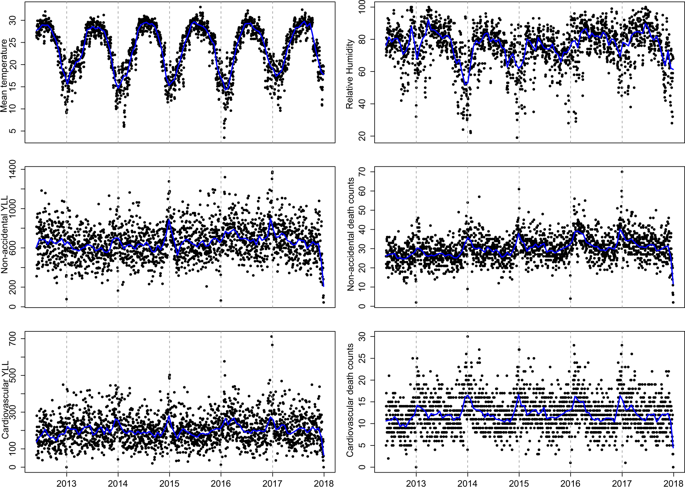当前位置:
X-MOL 学术
›
J. Expo. Sci. Environ. Epid.
›
论文详情
Our official English website, www.x-mol.net, welcomes your
feedback! (Note: you will need to create a separate account there.)
Years of life lost and mortality risk attributable to non-optimum temperature in Shenzhen: a time-series study.
Journal of Exposure Science and Environmental Epidemiology ( IF 4.1 ) Pub Date : 2020-02-13 , DOI: 10.1038/s41370-020-0202-x Hongyan Li 1 , Yao Yao 2, 3 , Yanran Duan 1 , Yi Liao 3 , Siyu Yan 1 , Xuehan Liu 1 , Zhiguang Zhao 3 , Yingbin Fu 3 , Ping Yin 1 , Jinquan Cheng 3 , Hongwei Jiang 1
Journal of Exposure Science and Environmental Epidemiology ( IF 4.1 ) Pub Date : 2020-02-13 , DOI: 10.1038/s41370-020-0202-x Hongyan Li 1 , Yao Yao 2, 3 , Yanran Duan 1 , Yi Liao 3 , Siyu Yan 1 , Xuehan Liu 1 , Zhiguang Zhao 3 , Yingbin Fu 3 , Ping Yin 1 , Jinquan Cheng 3 , Hongwei Jiang 1
Affiliation

|
To assess YLL and mortality burden attributable to non-optimum ambient temperature, we collected mortality and environmental data from June 1, 2012 to December 30, 2017 in Shenzhen. We applied distributed lag nonlinear models with 21 days of lag to examine temperature-YLL and temperature-mortality associations, and calculated the attributable fractions of YLL and deaths for non-optimum temperature, including four subranges, mild cold, mild heat, extreme cold, and extreme heat. Cold and heat were distinguished by the optimum temperature, and each was separated into extreme and mild by cutoffs at 2.5th (12.2 °C) and 97.5th (30.4 °C) temperature percentile further. The optimum temperature was defined as the temperature that had minimum effect on YLL or mortality risk. The optimum temperature for non-accidental YLL was 24.5 °C, and for mortality it was 25.4 °C. Except for the population older than 65 years, the optimum temperature was generally lower in the YLL model than the mortality model. Of the total 61,576 non-accidental deaths and 1,350,835.7 YLL within the study period, 17.28% (95% empirical CI 9.42-25.14%) of YLL and 17.27% (12.70-21.34%) of mortality were attributable to non-optimum temperature. More YLL was caused by cold (10.14%, 3.94-16.36%) than by heat (7.14%, 0.47-13.88%). Mild cold (12.2-24.5 °C) was responsible for far more YLL (8.78%, 3.00-14.61%) than extreme cold (3.5-12.2 °C). As for cardiovascular deaths, only the fractions attributable to overall and cold temperature were significant, with mild cold contributing the largest fraction to YLL (16.31%, 6.85-25.82%) and mortality (16.08%, 9.77-21.22%). Most of the temperature-related YLL and mortality was attributable to mild but non-optimum weather, especially mild cold, while the YLL model implied a more prominent heat effect on premature death. Our findings can supply additional evidence from multiperspectives for health planners to define priorities and make targeted policies for mitigating the burden of adverse temperatures.
中文翻译:

时间的序列研究表明,深圳气温不理想可导致多年的生命损失和死亡风险。
为了评估YLL和非最佳环境温度导致的死亡率负担,我们收集了2012年6月1日至2017年12月30日在深圳的死亡率和环境数据。我们应用了具有21天滞后的分布式滞后非线性模型来检查温度-YLL和温度-死亡率关联,并计算了非最佳温度的YLL归因分数和死亡,包括四个子范围,中度冷,中度热,极寒,和极热。最佳温度区分了冷热,并且通过在2.5%(12.2°C)和97.5th(30.4°C)温度百分数的临界值将温度分为极端和中等。最佳温度定义为对YLL或死亡风险影响最小的温度。非偶然YLL的最佳温度为24.5°C,死亡率为25.4°C。除了65岁以上的人口外,YLL模型中的最佳温度通常低于死亡率模型。在研究期内,总共61,576例非偶然死亡和1,350,835.7日元的YLL中,非最佳温度可归因于YLL的17.28%(95%的经验CI为9.42-25.14%)和17.27%(12.70-21.34%)的死亡率。与冷热(7.14%,0.47-13.88%)相比,冷(10.14%,3.94-16.36%)引起的YLL多。与极端寒冷(3.5-12.2°C)相比,轻微寒冷(12.2-24.5°C)造成的YLL(8.78%,3.00-14.61%)高得多。至于心血管疾病的死亡,仅归因于总体温度和寒冷温度的比例显着,轻度寒冷对YLL和死亡率的贡献最大(分别为16.31%,6.85-25.82%)(16.08%,9.77-21.22%)。与温度相关的大多数YLL和死亡率与温和但非最佳天气有关,尤其是轻度寒冷,而YLL模型暗示了对过早死亡的更显着的热效应。我们的发现可以从多角度为卫生计划人员提供更多证据,以帮助他们确定优先级并制定有针对性的政策来减轻不利温度的负担。
更新日期:2020-02-13
中文翻译:

时间的序列研究表明,深圳气温不理想可导致多年的生命损失和死亡风险。
为了评估YLL和非最佳环境温度导致的死亡率负担,我们收集了2012年6月1日至2017年12月30日在深圳的死亡率和环境数据。我们应用了具有21天滞后的分布式滞后非线性模型来检查温度-YLL和温度-死亡率关联,并计算了非最佳温度的YLL归因分数和死亡,包括四个子范围,中度冷,中度热,极寒,和极热。最佳温度区分了冷热,并且通过在2.5%(12.2°C)和97.5th(30.4°C)温度百分数的临界值将温度分为极端和中等。最佳温度定义为对YLL或死亡风险影响最小的温度。非偶然YLL的最佳温度为24.5°C,死亡率为25.4°C。除了65岁以上的人口外,YLL模型中的最佳温度通常低于死亡率模型。在研究期内,总共61,576例非偶然死亡和1,350,835.7日元的YLL中,非最佳温度可归因于YLL的17.28%(95%的经验CI为9.42-25.14%)和17.27%(12.70-21.34%)的死亡率。与冷热(7.14%,0.47-13.88%)相比,冷(10.14%,3.94-16.36%)引起的YLL多。与极端寒冷(3.5-12.2°C)相比,轻微寒冷(12.2-24.5°C)造成的YLL(8.78%,3.00-14.61%)高得多。至于心血管疾病的死亡,仅归因于总体温度和寒冷温度的比例显着,轻度寒冷对YLL和死亡率的贡献最大(分别为16.31%,6.85-25.82%)(16.08%,9.77-21.22%)。与温度相关的大多数YLL和死亡率与温和但非最佳天气有关,尤其是轻度寒冷,而YLL模型暗示了对过早死亡的更显着的热效应。我们的发现可以从多角度为卫生计划人员提供更多证据,以帮助他们确定优先级并制定有针对性的政策来减轻不利温度的负担。









































 京公网安备 11010802027423号
京公网安备 11010802027423号